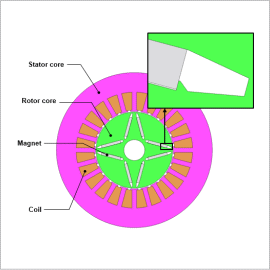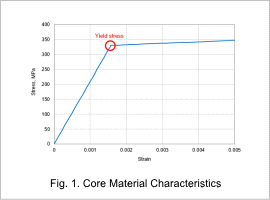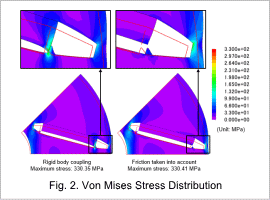*Please prepare a license ID and password for the license administrator.
*It is different from the service for JMAG WEB MEMBER (free membership). Please be careful.
Overview

In an IPM motor, magnets experience centrifugal force during high-speed rotation, generate friction while sliding, and are pressed against the rotor core, generating large stress. If the stress acting on a part exceeds its yield stress, plastic deformation occurs, which may cause a change in its properties or cause it to break. Therefore, it is necessary to create a design where yield stress is not exceeded even with centrifugal force.
By using simulation, the effects of centrifugal force can be checked and reflected in design before actually making the motor. During simulation, it is important to accurately simulate plastic deformation and part contacts.
In this example, in order to evaluate how the contacts between the magnets and the rotor core in an IPM motor affect the stress distribution, the von Mises stress is checked when there are rigid contacts and when the magnets are allowed to slide while the friction taken into account.
By using simulation, the effects of centrifugal force can be checked and reflected in design before actually making the motor. During simulation, it is important to accurately simulate plastic deformation and part contacts.
In this example, in order to evaluate how the contacts between the magnets and the rotor core in an IPM motor affect the stress distribution, the von Mises stress is checked when there are rigid contacts and when the magnets are allowed to slide while the friction taken into account.
Core Material Characteristics

Fig. 1 shows the core material characteristics. The yield stress of the material used is 330 MPa.
Von Mises Stress Distribution

Fig. 2 shows a comparison between von Mises stress distributions. Since for a rigid connection there is no slipping, a large stress is generated at the contacts. When taking into account friction, the magnet slides tangentially along contact area with the rotor core, generating large stress at the bridge. The distribution differs between the rigid connection case and the case when friction is taken into account. In actual phenomena, since it is thought that there is sliding and not a contact with a continuous rigid connection, it is understood that it is necessary to correctly model the contact state for accurate evaluation.
The von Mises stress maximum value exceeds the yield stress of 330 MPa. If left as is, plastic deformation occurs and the geometry changes, which may result in changes in characteristics or breakage, indicating that measures such as changing the material are necessary.
The von Mises stress maximum value exceeds the yield stress of 330 MPa. If left as is, plastic deformation occurs and the geometry changes, which may result in changes in characteristics or breakage, indicating that measures such as changing the material are necessary.


